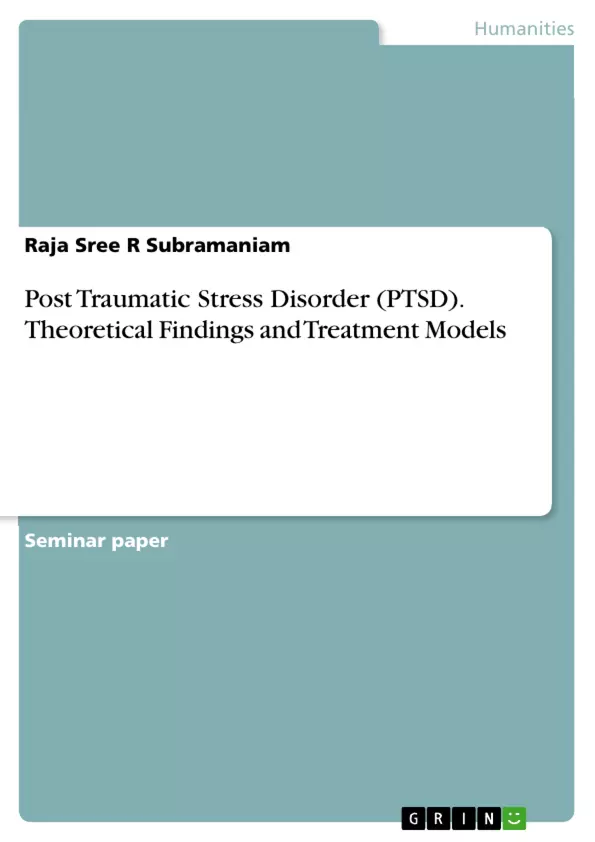The Diagnostic and Statistical Manual of Mental Disorders estimated 9-11 % of the general population experience traumatic distress and about half of the people who experienced trauma continue to develop Posttraumatic stress disorder (PTSD). PTSD is an anxiety disorder for which cognitive-behavioural therapy (CBT) is employed to treat or prevent maladaptive behaviour, beliefs and thought processes. According to the diagnostic criteria for PTSD, individuals exposed to trauma experience three distinct types of persistent post-trauma symptoms. The arousal symptom clusters describe re-experiencing traumatic moments, nightmares, flashbacks and sleep-disturbances. The second clusters of symptoms describe physiological responses such as helplessness, anger outbursts, concentration problems, hyper vigilance and exaggerated startle responses. The third cluster of symptoms describes avoidance and emotional numbing symptoms that leads to avoidance of people, trauma reminders, emotional dissociation and trouble recalling trauma events.
The persistent PTSD symptoms detrimentally affect mental health, social behaviour and occupational functioning. The issue whether PTSD symptoms own their existence to biological and learning or whether they are entirely cognitively determined has been the subject of much debate. Each approach provides evidence supporting fear activation and problems in emotion regulation leading to various symptoms of PTSD but these findings do not settle the issue for the maintenance of persistent symptoms of PTSD. In fact, it is posited that individual differences in the appraisal of trauma events and emotion regulation strategies determine the maintenance of the PTSD symptoms. Hence, the existing cognitive-behaviour therapy for PTSD was conceptualised to provide clinicians and therapists with an evidence-based framework that addresses individualised case formulation and treatment needs. The purpose of this essay is to discuss and evaluate the theoretical findings and treatment models, which contributed to the understanding of persistent symptoms of PTSD.
Inhaltsverzeichnis (Table of Contents)
- Introduction
- Prevalence and Impact of PTSD
- Behavioral Learning Theories
- Cognitive Models of PTSD
- Emotional Processing Network Model
- Dual Representation Theory
- Treatment Implications
Zielsetzung und Themenschwerpunkte (Objectives and Key Themes)
This essay aims to discuss and evaluate the theoretical findings and treatment models that have contributed to our understanding of persistent symptoms of Posttraumatic Stress Disorder (PTSD).
- The prevalence and impact of PTSD on individuals and society
- The role of learning and cognitive processes in the development and maintenance of PTSD
- The influence of emotion regulation and individual differences on PTSD symptoms
- The efficacy and limitations of cognitive behavioral therapy (CBT) for PTSD
- The application of theoretical models to inform treatment strategies for PTSD
Zusammenfassung der Kapitel (Chapter Summaries)
- Introduction: This section provides an overview of PTSD, its prevalence, and the impact on individuals and society. It also introduces the debate about the nature of PTSD, whether it is primarily biological, learned, or cognitive in origin.
- Prevalence and Impact of PTSD: This section discusses the prevalence of PTSD in various populations, including war veterans, war refugees, and victims of natural disasters. It highlights the economic and social burden of PTSD and the importance of early intervention.
- Behavioral Learning Theories: This section explores the classical and operant conditioning perspectives on PTSD. It examines Mowrer's two-factor theory of fear, which suggests that avoidance conditioning plays a role in maintaining PTSD symptoms.
- Cognitive Models of PTSD: This section delves into cognitive theories of PTSD, including Horowitz's stress response syndrome and Jaoff-Bulman's model of shattered assumptions. These models emphasize the role of cognitive processing, worldviews, and schema disruption in the development of PTSD.
- Emotional Processing Network Model: This section examines Foa and Kozak's emotional processing network model, which suggests that PTSD is characterized by fear networks that are resistant to modification. This model provides a framework for understanding the role of exposure therapy in treatment.
- Dual Representation Theory: This section explores Brewin and colleagues' dual representation theory, which proposes that PTSD involves difficulties in encoding and processing traumatic memories in two distinct brain systems: verbally accessible memory (VAMS) and situationally accessible memory (SAMS).
Schlüsselwörter (Keywords)
This preview focuses on the key concepts of Posttraumatic Stress Disorder (PTSD), including its prevalence, impact, and theoretical models of development and maintenance. The review explores the role of learning, cognition, emotion regulation, and treatment strategies such as cognitive behavioral therapy (CBT) and prolonged exposure therapy. The discussion highlights key themes such as fear networks, dual representation theory, and the influence of individual differences on PTSD symptoms.
- Quote paper
- Raja Sree R Subramaniam (Author), 2015, Post Traumatic Stress Disorder (PTSD). Theoretical Findings and Treatment Models, Munich, GRIN Verlag, https://www.grin.com/document/313310



